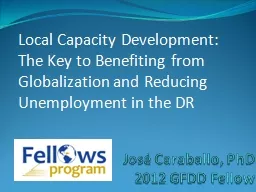PPT-Local Capacity Development:
Author : min-jolicoeur | Published Date : 2016-02-20
José Caraballo PhD 2012 GFDD Fellow Local Capacity Development The Key to Benefiting from Globalization and Reducing Unemployment in the DR Background Reasons
Presentation Embed Code
Download Presentation
Download Presentation The PPT/PDF document "Local Capacity Development: " is the property of its rightful owner. Permission is granted to download and print the materials on this website for personal, non-commercial use only, and to display it on your personal computer provided you do not modify the materials and that you retain all copyright notices contained in the materials. By downloading content from our website, you accept the terms of this agreement.
Local Capacity Development: : Transcript
Download Rules Of Document
"Local Capacity Development: "The content belongs to its owner. You may download and print it for personal use, without modification, and keep all copyright notices. By downloading, you agree to these terms.
Related Documents














